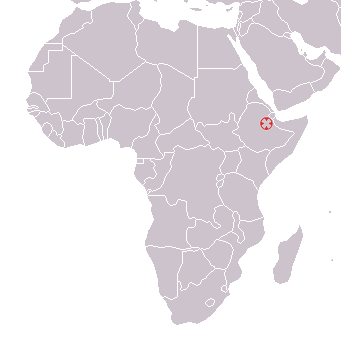
Australopithecus is a genus of early hominins that existed in Africa during the Late Pliocene and Early Pleistocene. The genus Homo emerged within Australopithecus, as sister to e.g. Australopithecus sediba. Also the genera Paranthropus and Kenyanthropus emerged within Australopithecus. Australopithecus is a member of the subtribe Australopithecina, which sometimes also includes Ardipithecus, though the term "australopithecine" is sometimes used to refer only to members of Australopithecus. Species include A. garhi, A. africanus, A. sediba, A. afarensis, A. anamensis, A. bahrelghazali and A. deyiremeda. Debate exists as to whether some Australopithecus species should be reclassified into new genera, or if Paranthropus and Kenyanthropus are synonymous with Australopithecus, in part because of the taxonomic inconsistency.

The Olduvai Gorge or Oldupai Gorge in Tanzania is one of the most important paleoanthropological localities in the world; the many sites exposed by the gorge have proven invaluable in furthering understanding of early human evolution. A steep-sided ravine in the Great Rift Valley that stretches across East Africa, it is about 48 km (30 mi) long, and is located in the eastern Serengeti Plains within the Ngorongoro Conservation Area in the Olbalbal ward located in Ngorongoro District of Arusha Region, about 45 kilometres from Laetoli, another important archaeological locality of early human occupation. The British/Kenyan paleoanthropologist-archeologist team of Mary and Louis Leakey established excavation and research programs at Olduvai Gorge that achieved great advances in human knowledge and are world-renowned. The site is registered as one of the National Historic Sites of Tanzania.

The Oldowan was a widespread stone tool archaeological industry (style) in prehistory. These early tools were simple, usually made with one or a few flakes chipped off with another stone. Oldowan tools were used during the Lower Paleolithic period, 2.6 million years ago up until at least 1.7 million years ago, by ancient Hominins across much of Africa. This technological industry was followed by the more sophisticated Acheulean industry.
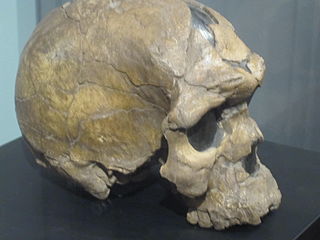
Herto Man refers to the 154,000 - 160,000-year-old human remains discovered in 1997 from the Upper Herto member of the Bouri Formation in the Afar Triangle, Ethiopia. The discovery of Herto Man was especially significant at the time, as it fell within a long gap in the fossil record between 300 and 100 thousand years ago, and at its description in 2003, it represented the oldest dated H. sapiens remains. In the original description paper, these 12 individuals were described as falling just outside the umbrella of "anatomically modern human". Thus, Herto Man was classified into a new subspecies as "H. s. idaltu". It supposedly represented a transitional morph between the more archaic "H. (s.?) rhodesiensis and H. s. sapiens. Subsequent researchers have rejected this classification. The validity of such subspecies is difficult to justify because of the vague definitions of "species" and "subspecies", especially when discussing a chronospecies, as the exact end-morphology and start-morphology of the ancestor and descendant species are inherently unresolvable.
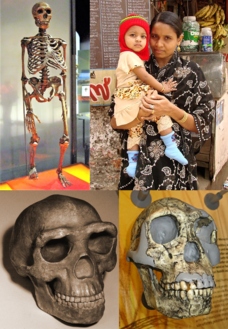
Homo is the genus that emerged in the genus Australopithecus that encompasses the extant species Homo sapiens, plus several extinct species classified as either ancestral to or closely related to modern humans, most notably Homo erectus and Homo neanderthalensis. The genus emerged with the appearance of Homo habilis just over 2 million years ago. Homo, together with the genus Paranthropus, is probably sister to Australopithecus africanus, which itself had previously split from the lineage of Pan, the chimpanzees.

Australopithecus anamensis is a hominin species that lived approximately between 4.2 and 3.8 million years ago and is the oldest known Australopithecus species, living during the Plio-Pleistocene era.

Australopithecus garhi is a species of australopithecine from the Bouri Formation in the Afar Region of Ethiopia 2.6–2.5 million years ago (mya) during the Early Pleistocene. The first remains were described in 1999 based on several skeletal elements uncovered in the three years preceding. A. garhi was originally considered to have been a direct ancestor to Homo and the human line, but is now thought to have been an offshoot. Like other australopithecines, A. garhi had a brain volume of 450 cc (27 cu in); a jaw which jutted out (prognathism); relatively large molars and premolars; adaptations for both walking on two legs (bipedalism) and grasping while climbing (arboreality); and it is possible that, though unclear if, males were larger than females. One individual, presumed female based on size, may have been 140 cm tall.

Human taxonomy is the classification of the human species within zoological taxonomy. The systematic genus, Homo, is designed to include both anatomically modern humans and extinct varieties of archaic humans. Current humans have been designated as subspecies Homo sapiens sapiens, differentiated, according to some, from the direct ancestor, Homo sapiens idaltu.

Koobi Fora refers primarily to a region around Koobi Fora Ridge, located on the eastern shore of Lake Turkana in the territory of the nomadic Gabbra people. According to the National Museums of Kenya, the name comes from the Gabbra language:
In the language of the Gabbra people who live near the site, the term Koobi Fora means a place of the commiphora and the source of myrrh...

Tim D. White is an American paleoanthropologist and Professor of Integrative Biology at the University of California, Berkeley. He is best known for leading the team which discovered Ardi, the type specimen of Ardipithecus ramidus, a 4.4 million-year-old likely human ancestor. Prior to that discovery, his early career was notable for his work on Lucy as Australopithecus afarensis with discoverer Donald Johanson.
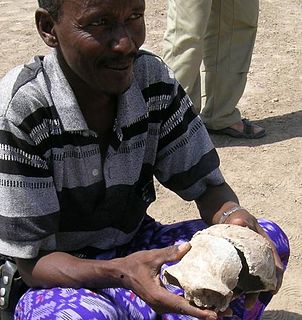
The Gawis cranium is a portion of a fossil hominin skull discovered on February 16, 2006 near the drainage of Gawis, a tributary of the Awash River in the Afar Depression, Ethiopia. Despite the presence of volcanic ash layers that are key to dating, the cranium is only generally dated between 200,000 and 500,000 years ago due to taphonomic issues.

The Middle Awash is a paleoanthropological research area in the Afar Region along the Awash River in Ethiopia's Afar Depression. It is a unique natural laboratory for the study of human origins and evolution and a number of fossils of the earliest hominins, particularly of the Australopithecines, as well as some of the oldest known Olduwan stone artifacts, have been found at the site—all of late Miocene, the Pliocene, and the very early Pleistocene times, that is, about 5.6 million years ago (mya) to 2.5 mya. It is broadly thought that the divergence of the lines of the earliest humans (hominins) and of chimpanzees (hominids) was completed near the beginning of that time range, or sometime between seven and five mya. However, the larger community of scientists provide several estimates for periods of divergence that imply a greater range for this event, see CHLCA: human-chimpanzee split.
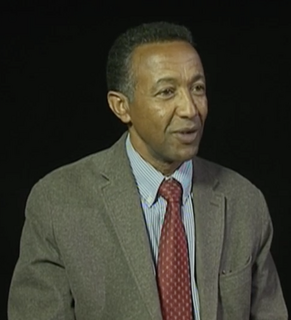
Yohannes Haile-SelassieAmbaye is an Ethiopian paleoanthropologist. An authority on pre-Homo sapiens hominids, he particularly focuses his attention on the East African Rift and Middle Awash valleys. He was curator of Physical Anthropology at the Cleveland Museum of Natural History from 2002 until 2021, and now is serving as the director of the Arizona State University Institute of Human Origins. Since founding the institute in 1981, he has been the third director after Donald Johanson and William Kimbel.
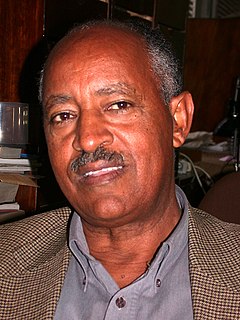
Berhane Asfaw is an Ethiopian paleontologist of Rift Valley Research Service, who co-discovered human skeletal remains at Herto Bouri, Ethiopia later classified as Homo sapiens idaltu, proposed as an early subspecies of anatomically modern humans.
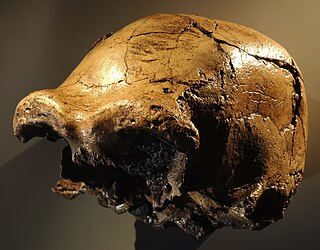
The Daka calvaria, otherwise known as the Dakaskull, or specimen number BOU-VP-2/66, is a Homo erectus specimen from the Daka Member of the Bouri Formation in the Middle Awash Study Area of the Ethiopian Rift Valley.

The Bodo cranium is a fossil of an extinct type of hominin species. It was found by members of an expedition led by Jon Kalb in 1976. The Rift Valley Research Mission conducted a number of surveys that led to the findings of Acheulean tools and animal fossils, as well as the Bodo Cranium. The initial discovery was by Alemayhew Asfaw and Charles Smart, who found a lower face. Two weeks later, Paul Whitehead and Craig Wood found the upper portion of the face. Pieces of the cranium were discovered along the surface of one of the dry branches of the Awash River in Ethiopia. The cranium, artifacts, and other animal fossils were found over a relatively large area of medium sand, and only a few of the tools were found near the cranium. The skull is 600,000 years old and is now the type specimen of Homo bodoensis. (formerly Homo heidelbergensis / Homo rhodesiensis).

Several expansions of populations of archaic humans out of Africa and throughout Eurasia took place in the course of the Lower Paleolithic, and into the beginning Middle Paleolithic, between about 2.1 million and 0.2 million years ago (Ma). These expansions are collectively known as Out of Africa I, in contrast to the expansion of Homo sapiens (anatomically modern humans) into Eurasia, which may have begun shortly after 0.2 million years ago.
The Middle Awash Project is an international research expedition conducted in the Afar region of Ethiopia with the goal of determining the origins of humanity. The project has the approval of the Ethiopian Culture Ministry and a strong commitment to developing Ethiopian archaeology, paleontology and geology research infrastructure. This project has discovered over 260 fossil specimens and over 17,000 vertebrate fossil specimens to date ranging from 200,000 to 6,000,000 years in age. Researchers have discovered the remains of four hominin species, the earliest subspecies of homo sapiens as well as stone tools. All specimens are permanently held at the National Museum of Ethiopia, where the project’s laboratory work is conducted year round.

The Dmanisi hominins, Dmanisi people, or Dmanisi man were a population of Early Pleistocene hominins whose fossils have been recovered at Dmanisi, Georgia. The fossils and stone tools recovered at Dmanisi range in age from 1.85–1.77 million years old, making the Dmanisi hominins the earliest well-dated hominin fossils in Eurasia and the best preserved fossils of early Homo from a single site so early in time, though earlier fossils and artifacts have been found in Asia. Though their precise classification is controversial and disputed, the Dmanisi fossils are highly significant within research on early hominin migrations out of Africa. The Dmanisi hominins are known from over a hundred postcranial fossils and five famous well-preserved skulls, referred to as Dmanisi Skulls 1–5.
Gona is an archaeological site in the Afar Triangle of Ethiopia located in the Ethiopian Lowlands. The site, near the Middle Awash and Hadar regions, is primarily known for paleoanthropological study, including excavations of Late Miocene and Early Pliocene fossils, as well as Oldowan and Acheulean stone tools. Evidence of Homo erectus presence at Gona dates back to as early as 1.8 million years ago, making Gona's stone tools some of the world's oldest stone tool artifacts found to date. Gona is also known as a key site for the study of human evolution, with a rich hominid fossil record that includes evidence of Ardipithecus remains dating to around 4.5 million years old and Homo erectus fossils from approximately 1.8 to 1.7 million years ago. Likewise, faunal remains such as cutmarked bones from Gona give insight into early hominid diets and butchery practices, making it an important site for zooarchaeology.
